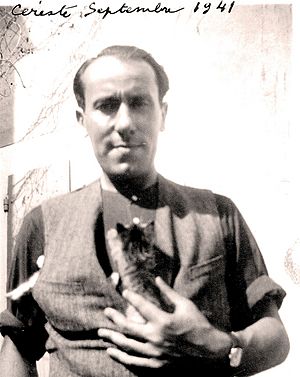René Char facts for kids
Quick facts for kids
René Char
|
|
|---|---|
 |
|
| Born | 14 June 1907 L'Isle-sur-la-Sorgue, France |
| Died | 19 February 1988 (aged 80) Paris, France |
| Occupation | Poet |
| Nationality | French |
| Period | 1920–1940 |
| Genre | Poetry |
René Char was a famous French poet who lived from 1907 to 1988. He was also a brave member of the French Resistance, a group that fought against the occupation of France during World War II.
Contents
About René Char
René Émile Char was born on June 14, 1907, in a town called L'Isle-sur-la-Sorgue in France. He was the youngest of four children. His father was the mayor of their town and managed a plaster factory. René grew up in a large family home called Névons.
As a student, he went to school in Avignon and later to a business school in Marseille in 1925. He loved to read many classic writers like Plutarch, François Villon, and Racine. He was also very tall (1.92 meters, which is about 6 feet 3 inches) and enjoyed playing rugby. In 1927, he served in the military in Nîmes.
Becoming a Poet
René Char's first book of poems, Cloches sur le cœur, came out in 1928. It included poems he had written between 1922 and 1926. In 1929, he started a journal called Méridiens with André Cayatte.
Later that year, he sent some of his poems to another famous poet, Paul Éluard. Éluard was impressed and visited René. Soon after, René moved to Paris. There, he met other important writers like Louis Aragon and André Breton. He joined a group of artists and writers called the Surrealists. This group explored dreams and the imagination in their art.
René Char was active with the Surrealists in the early 1930s. Over his career, his poems were often published with artwork by famous artists. These included Kandinsky, Picasso, Braque, Miró, Matisse, and Vieira da Silva.
Fighting in the Resistance
When World War II started, René Char joined the French Resistance in 1940. He used the code name Captain Alexandre. He helped lead a secret parachute drop zone in the Durance area.
During the war, he refused to publish any new works. Instead, he wrote "Feuillets d'Hypnos" (which means "Leaves of Hypnos") between 1943 and 1944. These were prose poems about his experiences in the Resistance. They were published in 1946 and became very famous.
Later Life and Friends
After the war, René Char continued to write poetry. In the 1960s, he joined a fight against placing atomic weapons in Provence. He passed away from a heart attack in Paris in 1988.
René Char had many famous friends. He was close with writers like Albert Camus, Georges Bataille, and Maurice Blanchot. He was also friends with artists such as Pablo Picasso, Joan Miró, and Victor Brauner. He was supposed to be in the car with Albert Camus when Camus died in an accident, but there wasn't enough room, so René took a train instead.
The composer Pierre Boulez created music based on some of Char's poems. René also became friends with the philosopher Martin Heidegger, who admired his poetry.
Important Works
René Char wrote many books of poetry. Here are some of his notable works:
- Ralentir Travaux (1930 – written with André Breton and Paul Éluard)
- Le Marteau sans maître (1934)
- Moulin premier (1936)
- Placard pour un chemin des écoliers (1937)
- Dehors la nuit est gouvernée (1938)
- Seuls demeurent (1945)
- Feuillets d'Hypnos (1946)
- Le Poème pulvérisé (1947)
- Fureur et mystère (1948)
- Les Matinaux (1950)
- Recherche de la base et du sommet (1955)
- La Parole en archipel (1962)
- L'Âge cassant (1965)
- Dans la Pluie giboyeuse (1968)
- Le Nu perdu (1971)
- La Nuit talismanique (1972)
- Le Bâton de rosier
- Aromates chasseurs (1976)
- Chants de la Balandrane (1977)
- Fenêtres dormantes et porte sur le toit (1979)
- Loin de nos cendres (1983)
- Les voisinages de Van Gogh (1985)
- Éloge d'une soupçonnée (1988)
His complete works, called Œuvres complètes, were published in a famous collection called Bibliothèque de la Pléiade in 1983.
Translations of His Work
Many poets have translated René Char's poems into English. Some of these include William Carlos Williams, Samuel Beckett, Richard Wilbur, James Wright, John Ashbery, and Paul Auster. His works have also been translated into German by poets like Paul Celan and Peter Handke, and into Bulgarian by Georgi Mitzkov and Zlatozar Petrov.
See also
 In Spanish: René Char para niños
In Spanish: René Char para niños
- Le Monde's 100 Books of the Century, a list which includes Fureur et mystère

